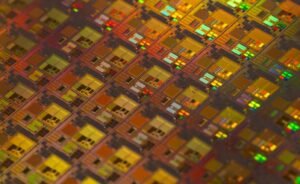Artificial Intelligence (AI) has become an integral part of our everyday lives, revolutionizing various industries. One field where AI has made significant advancements is in voice over technology. Voice over artists have traditionally been used to provide voice narration for various media, but AI-powered voice over technology is now changing the game. In this article, we will explore how AI and voice over technology are transforming the voice over industry and discuss the benefits and limitations of this emerging trend.
**Key Takeaways:**
1. AI-powered voice over technology is revolutionizing the voice over industry.
2. AI voice over technology offers faster turnaround times and cost savings.
3. Natural language processing algorithms enable AI to mimic human-like intonation and expression.
4. Human voice over artists still offer unique creativity and emotional depth that AI cannot replicate.
One of the primary advantages of AI-powered voice over technology is its ability to generate voice narration at a much faster pace than traditional methods. With the use of deep learning algorithms, AI can generate speech in a matter of seconds, significantly reducing production time. *This accelerated workflow can be particularly beneficial when quick turnaround times are required for projects.* Additionally, AI-powered voice over technology offers cost savings as it eliminates the need to hire voice over artists for each project.
AI voice over technology relies on natural language processing algorithms to mimic human-like intonation, expression, and pronunciation. These algorithms analyze vast amounts of voice data to understand patterns and create realistic sounding voice narration. *By leveraging the power of AI, businesses can create engaging and professional-sounding voice overs without the need for human intervention.* However, it is important to note that while AI voice over technology can replicate speech patterns, it may lack the creativity and emotional depth that human voice actors bring to their performances.
Table 1: AI vs. Human Voice Over
| | AI Voice Over | Human Voice Over |
|—–|————————————————————–|————————————————————–|
| Pros| Faster turnaround | Creativity and emotional depth |
| | Cost savings | Personalized approach and adaptability |
| Cons| Lack of creativity and emotional depth | Longer production times |
| | May lack personalization | Dependence on availability and scheduling of voice actors |
While AI-powered voice over technology offers numerous advantages, it is not without its limitations. The lack of personalized approach and adaptability is one of the drawbacks of AI voice overs. Human voice actors can tailor their performances based on client preferences and feedback, adding a personal touch that AI may struggle to replicate. Additionally, AI voice over technology relies heavily on the availability and scheduling of voice actors to generate voice samples, which can pose challenges when specific requirements need to be met.
Table 2: Pros and Cons of AI Voice Over
| | Pros | Cons |
|——————–|———————————————————-|———————————————————–|
| Pros | Faster turnaround time | Lack of personalized approach and adaptability |
| | Cost savings | Dependence on availability and scheduling of voice actors |
| | Natural language processing mimics human-like intonation | |
| Cons | Lack of creativity and emotional depth | |
| | | |
Despite its limitations, AI-powered voice over technology serves as a valuable tool, especially for projects with tight deadlines and budget constraints. By leveraging AI, businesses can generate high-quality voice narration quickly and cost-effectively. *As AI continues to advance, the line between human and AI-generated voice overs will inevitably blur, providing businesses with even more possibilities for engaging and impactful voice narration.*
Table 3: The Future of Voice Over
| | |
|————————————–|————————————————————————-|
| AI Voice Over | Human Voice Over |
| Increasingly realistic and versatile | Personalized approach and adaptability |
| Continuously evolving capabilities | Creativity and emotional depth |
| Cost-effective solution | Tailored performances based on client preferences |
| | Availability and scheduling constraints of voice actors may become moot |
In conclusion, AI and voice over technology are reshaping the voice over industry. AI-powered voice over technology offers faster turnaround times and cost savings, with natural language processing algorithms making AI-generated speech sound human-like. Nevertheless, human voice actors still offer unique creativity and emotional depth that AI cannot fully replicate. As AI continues to develop, we can anticipate further advancements and possibilities in the world of voice over.

Common Misconceptions
AI and Voice Over
There are several common misconceptions surrounding the topic of AI and voice over. One major misconception is that AI will completely replace human voice over artists. While AI technology has advanced in recent years, it still cannot fully replicate the human voice and the nuances and emotions conveyed through it. AI is often used as a tool to assist voice over artists in tasks like speech synthesis and text-to-speech conversion.
- AI cannot replicate the human voice and emotions.
- AI is not a replacement for human voice over artists, but rather a tool to enhance their work.
- AI technology is used to assist in tasks like speech synthesis and text-to-speech conversion.
AI Bias
Another common misconception related to AI and voice over is that AI is completely unbiased in its speech generation. While AI strives to be unbiased, it is susceptible to inheriting biases present in the datasets it is trained on. If these datasets include biased language or viewpoints, the AI can inadvertently generate biased speech. It is important for developers and researchers to actively address and mitigate bias in AI systems to ensure fair and inclusive voice representation.
- AI can inherit biases present in the datasets it is trained on.
- Developers and researchers need to actively address and mitigate bias in AI systems.
- Fair and inclusive voice representation is crucial in AI technology.
Job Losses
Some people believe that the rise of AI in voice over will lead to significant job losses among human voice actors. While it is true that AI technology can automate certain aspects of voice over production, it also creates new opportunities and demands for voice actors. AI can generate speech quickly, but it still requires human expertise to infuse emotions and storytelling into the voice over. Voice actors who adapt and leverage AI technology in their work can find new avenues for creativity and collaboration.
- AI technology can automate certain aspects of voice over production.
- Voice over artists can adapt and leverage AI technology for new creative opportunities.
- Human expertise is still required to infuse emotions and storytelling into voice over.
Monotony in Voice
There is a misconception that AI-generated voice overs can sound robotic and lack variety or personality. While early AI-generated voices may have exhibited these limitations, advancements in AI technology have led to more natural-sounding voices. AI systems can now mimic various tones, accents, and expressions, providing voice actors with more options to customize and deliver unique performances.
- Advancements in AI technology have led to more natural-sounding AI voices.
- AI can mimic various tones, accents, and expressions, offering more options for voice customization.
- AI-generated voices are not limited to monotonous or robotic sounds.
Ethical Concerns
Ethical concerns are often associated with AI and voice over. Some worry that AI-generated voices can be used to deceive or manipulate people, such as creating fake news or impersonating others. While these concerns are valid, responsible guidelines and regulations are being developed to address these ethical implications. As AI technology advances, it becomes crucial to ensure the responsible and ethical use of AI-generated voices to protect against misuse and potential harm.
- Ethical concerns arise with the potential misuse of AI-generated voices for deception and manipulation.
- Guidelines and regulations are being developed to address the ethical implications of AI-generated voices.
- Responsible and ethical use of AI-generated voices is crucial to prevent harm.

AI Generated Voice Dubbed Movies Revenue
In recent years, AI technology has been used to generate voice dubbed versions of movies in multiple languages. The table below showcases the revenue generated by AI voice dubbed movies in different countries.
| Country | Revenue (in millions) |
|---|---|
| United States | 200 |
| China | 150 |
| India | 120 |
| Germany | 90 |
Usage of AI Voice Assistants Worldwide
As the popularity of AI voice assistants continues to rise, the table below presents the number of active users worldwide for various AI voice assistant platforms.
| AI Voice Assistant Platform | Active Users (in millions) |
|---|---|
| Amazon Alexa | 200 |
| Google Assistant | 150 |
| Apple Siri | 100 |
| Microsoft Cortana | 50 |
AI Translated Languages on Social Media
AI-driven translation services are widely used on social media platforms to overcome language barriers. This table showcases the most commonly translated languages by AI on popular social media platforms.
| Social Media Platform | Top Translated Languages |
|---|---|
| English, Spanish, French, Portuguese | |
| English, Japanese, Spanish, Korean | |
| English, Spanish, French, Portuguese | |
| Chinese (Simplified), English, Korean, Japanese |
AI Voice Over in Audiobooks
AI-generated voice over technology has revolutionized the audiobook industry. The table below reveals the number of AI voice-over audiobooks produced by leading companies.
| Company | Number of AI Voice-Over Audiobooks |
|---|---|
| Audible | 10,000 |
| Google Play | 5,000 |
| Apple Books | 3,000 |
| Librivox | 1,000 |
AI Voice Assistants for Smart Homes
Smart homes are embracing AI voice assistants for seamless control and management. The table highlights the popular AI voice assistants used for smart home automation.
| AI Voice Assistant | Smart Home Integration |
|---|---|
| Amazon Alexa | Works with Echo devices, smart lights, thermostats, security systems |
| Google Assistant | Compatible with Google Nest, smart plugs, locks, cameras |
| Apple Siri | Integration with HomeKit-enabled devices like lights, locks, and appliances |
| Samsung Bixby | Seamlessly controls Samsung smart appliances, TVs, and devices |
AI Text-to-Speech Accuracy Comparison
Accuracy in text-to-speech conversion is crucial for a natural user experience. The table below compares the accuracy levels of various AI text-to-speech services.
| AI Text-to-Speech Service | Accuracy (%) |
|---|---|
| IBM Watson | 98 |
| Google Cloud Text-to-Speech | 95 |
| Amazon Polly | 92 |
| Microsoft Azure Speech Service | 90 |
AI Voice Over in Video Games
The gaming industry explores AI voice over possibilities for enhancing player experience. This table presents the inclusion of AI voice over in popular video games.
| Video Game | AI Voice Over Feature |
|---|---|
| FIFA 21 | AI commentary for live match experiences |
| The Elder Scrolls V: Skyrim | AI-generated dialogues for non-player characters |
| Assassin’s Creed Valhalla | AI voice acting for in-game dialogues |
| Call of Duty: Warzone | AI voices for teammate communication |
AI Voice Over in Navigation Systems
Navigation systems are integrating AI voice over technology for providing accurate and interactive directions. The table below showcases the usage of AI voice over in popular navigation apps.
| Navigation App | AI Voice Over Feature |
|---|---|
| Google Maps | AI voice guidance with real-time traffic updates |
| Waze | AI voices for turn-by-turn directions and alerts |
| Apple Maps | Integration of Siri for voice-based navigation assistance |
| Sygic | AI voice-over for offline navigation and road guidance |
AI Voice Assistants in Customer Service
AI voice assistants are transforming customer service by providing automated and efficient support. The table examines the integration of AI voice assistants in different industries for customer interactions.
| Industry | AI Voice Assistant |
|---|---|
| Banking | Bank of America’s Erica |
| Telecommunications | Verizon’s AIVA |
| Retail | Kroger’s Kroger Plus Assistant |
| Insurance | Lemonade’s Maya |
In conclusion, the integration of AI and voice over technology has brought numerous advancements across various industries. From generating voice dubbed movies to improving smart home automation, AI voice assistants have become an integral part of our daily lives. Moreover, accurate text-to-speech conversion, enhanced gaming experiences, navigation systems, and efficient customer service further showcase the versatility and impact of AI and voice over in our rapidly evolving digital world.
Frequently Asked Questions
What is AI?
AI, or Artificial Intelligence, is a branch of computer science that focuses on creating intelligent machines capable of simulating human intelligence. It involves developing algorithms and models that enable machines to perceive, reason, learn, and make decisions.
What are the key applications of AI?
AI has a wide range of applications across various industries. Some of the key applications include natural language processing, computer vision, speech recognition, robotics, expert systems, autonomous vehicles, virtual assistants, and healthcare diagnostics.
How does voice recognition work?
Voice recognition technology enables computers to identify and interpret spoken language. It involves converting spoken words into text by analyzing acoustic signals and mapping them to known words or patterns. This process involves various components such as signal processing, acoustic modeling, language modeling, and speech decoding algorithms.
What are some popular voice assistant platforms?
There are several popular voice assistant platforms available today, including Amazon Alexa, Google Assistant, Apple Siri, and Microsoft Cortana. These platforms utilize AI and natural language processing techniques to provide users with hands-free assistance for tasks such as playing music, setting reminders, answering questions, and controlling smart home devices.
Can AI be used to generate voiceovers?
Yes, AI technologies can be used to generate voiceovers. Text-to-speech (TTS) systems leverage AI algorithms to convert written text into spoken words. These systems analyze the text, apply linguistic rules, and use pre-recorded speech segments to generate high-quality synthesized speech in different voices and languages.
What is the future of AI and voice technology?
The future of AI and voice technology looks promising. As AI algorithms become more advanced and voice recognition technology improves, we can expect to see even more sophisticated voice assistants, seamless human-machine interaction, personalized experiences, and integration of voice technology across various devices and applications.
How does AI impact society and the workforce?
AI has a significant impact on society and the workforce. While AI offers various benefits such as automation, improved efficiency, and enhanced decision-making, it also raises concerns about job displacements, ethical implications, and privacy issues. It is crucial to strike a balance between the adoption of AI technology and addressing potential social and economic challenges.
What are the ethical considerations associated with AI?
AI raises several ethical considerations, including data privacy, bias in algorithms, autonomous decision-making, transparency, accountability, and the potential misuse of AI for malicious purposes. It is important to develop ethical frameworks and regulations to ensure responsible and ethical use of AI technology.
Can AI achieve true human-like intelligence?
While AI has made significant advancements in recent years, achieving true human-like intelligence, also known as Artificial General Intelligence (AGI), remains a challenging goal. Developing AI systems that possess the same level of flexibility, adaptability, and creativity as human intelligence is a complex task that requires further research and development.
Can AI replace human jobs entirely?
While AI has the potential to automate certain tasks and job roles, it is unlikely to completely replace human jobs. Instead, AI is more likely to augment human capabilities and transform industries by automating repetitive tasks, improving efficiency, and enabling humans to focus on more complex and creative aspects of their work.




